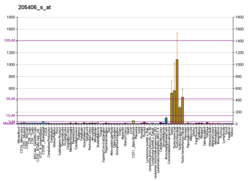| SPA17 | |||||||||||||||||||||||||||||||||||||||||||||||||||
|---|---|---|---|---|---|---|---|---|---|---|---|---|---|---|---|---|---|---|---|---|---|---|---|---|---|---|---|---|---|---|---|---|---|---|---|---|---|---|---|---|---|---|---|---|---|---|---|---|---|---|---|
| Identifiers | |||||||||||||||||||||||||||||||||||||||||||||||||||
| Aliases | SPA17, CT22, SP17, SP17-1, sperm autoantigenic protein 17 | ||||||||||||||||||||||||||||||||||||||||||||||||||
| External IDs | OMIM: 608621; MGI: 1333778; HomoloGene: 7951; GeneCards: SPA17; OMA:SPA17 - orthologs | ||||||||||||||||||||||||||||||||||||||||||||||||||
| |||||||||||||||||||||||||||||||||||||||||||||||||||
| |||||||||||||||||||||||||||||||||||||||||||||||||||
| |||||||||||||||||||||||||||||||||||||||||||||||||||
| |||||||||||||||||||||||||||||||||||||||||||||||||||
| |||||||||||||||||||||||||||||||||||||||||||||||||||
| Wikidata | |||||||||||||||||||||||||||||||||||||||||||||||||||
| |||||||||||||||||||||||||||||||||||||||||||||||||||
Sperm surface protein Sp17 is a protein that in humans is encoded by the SPA17 gene.
This gene encodes a protein present at the cell surface. Studies in rabbits suggest that in sperm the protein is involved in fertilization by binding to the zona pellucida of the oocyte. Other studies in rabbits suggest that it is also involved in additional cell-cell adhesion functions such as immune cell migration and metastasis.
References
- ^ GRCh38: Ensembl release 89: ENSG00000064199 – Ensembl, May 2017
- ^ GRCm38: Ensembl release 89: ENSMUSG00000001948 – Ensembl, May 2017
- "Human PubMed Reference:". National Center for Biotechnology Information, U.S. National Library of Medicine.
- "Mouse PubMed Reference:". National Center for Biotechnology Information, U.S. National Library of Medicine.
- Lea IA, Richardson RT, Widgren EE, O'Rand MG (Aug 1996). "Cloning and sequencing of cDNAs encoding the human sperm protein, Sp17". Biochim Biophys Acta. 1307 (3): 263–6. doi:10.1016/0167-4781(96)00077-2. PMID 8688458.
- ^ "Entrez Gene: SPA17 sperm autoantigenic protein 17".
Further reading
- McLeskey SB, Dowds C, Carballada R, et al. (1997). Molecules involved in mammalian sperm-egg interaction. International Review of Cytology. Vol. 177. pp. 57–113. doi:10.1016/S0074-7696(08)62231-7. ISBN 9780123645814. PMID 9378618.
{{cite book}}:|journal=ignored (help) - Richardson RT, Yamasaki N, O'Rand MG (1994). "Sequence of a rabbit sperm zona pellucida binding protein and localization during the acrosome reaction". Dev. Biol. 165 (2): 688–701. doi:10.1006/dbio.1994.1285. PMID 7525387.
- Kong M, Richardson RT, Widgren EE, O'Rand MG (1995). "Sequence and localization of the mouse sperm autoantigenic protein, Sp17". Biol. Reprod. 53 (3): 579–90. doi:10.1095/biolreprod53.3.579. PMID 7578682.
- Fujita A, Nakamura K, Kato T, et al. (2000). "Ropporin, a sperm-specific binding protein of rhophilin, that is localized in the fibrous sheath of sperm flagella". J. Cell Sci. 113 (1): 103–12. doi:10.1242/jcs.113.1.103. hdl:2433/181273. PMID 10591629.
- Wen Y, Richardson RT, Widgren EE, O'Rand MG (2001). "Characterization of Sp17: a ubiquitous three domain protein that binds heparin". Biochem. J. 357 (Pt 1): 25–31. doi:10.1042/0264-6021:3570025. PMC 1221924. PMID 11415432.
- De Jong A, Buchli R, Robbins D (2003). "Characterization of sperm protein 17 in human somatic and neoplastic tissue". Cancer Lett. 186 (2): 201–9. doi:10.1016/S0304-3835(02)00350-6. PMID 12213290.
- Buchli R, De Jong A, Robbins DL (2002). "Genomic organization of an intron-containing sperm protein 17 gene (Sp17-1) and an intronless pseudogene (Sp17-2) in humans: a new model". Biochim. Biophys. Acta. 1578 (1–3): 29–42. doi:10.1016/S0167-4781(02)00478-5. PMID 12393185.
- Strausberg RL, Feingold EA, Grouse LH, et al. (2003). "Generation and initial analysis of more than 15,000 full-length human and mouse cDNA sequences". Proc. Natl. Acad. Sci. U.S.A. 99 (26): 16899–903. Bibcode:2002PNAS...9916899M. doi:10.1073/pnas.242603899. PMC 139241. PMID 12477932.
- Frayne J, Hall L (2003). "A re-evaluation of sperm protein 17 (Sp17) indicates a regulatory role in an A-kinase anchoring protein complex, rather than a unique role in sperm-zona pellucida binding". Reproduction. 124 (6): 767–74. doi:10.1530/rep.0.1240767. PMID 12530914.
- Takeoka Y, Kenny TP, Yago H, et al. (2004). "Developmental considerations of sperm protein 17 gene expression in rheumatoid arthritis synoviocytes". Dev. Immunol. 9 (2): 97–102. doi:10.1080/1044667021000095186. PMC 2276097. PMID 12739786.
- Chiriva-Internati M, Wang Z, Pochopien S, et al. (2004). "Identification of a sperm protein 17 CTL epitope restricted by HLA-A1". Int. J. Cancer. 107 (5): 863–5. doi:10.1002/ijc.11486. PMID 14566839. S2CID 30452400.
- Straughn JM, Shaw DR, Guerrero A, et al. (2004). "Expression of sperm protein 17 (Sp17) in ovarian cancer". Int. J. Cancer. 108 (6): 805–11. doi:10.1002/ijc.11617. PMID 14712480. S2CID 20294805.
- Lea IA, Widgren EE, O'Rand MG (2004). "Association of sperm protein 17 with A-kinase anchoring protein 3 in flagella". Reprod. Biol. Endocrinol. 2: 57. doi:10.1186/1477-7827-2-57. PMC 484205. PMID 15257753.
- Wang Z, Zhang Y, Ramsahoye B, et al. (2004). "Sp17 gene expression in myeloma cells is regulated by promoter methylation". Br. J. Cancer. 91 (8): 1597–603. doi:10.1038/sj.bjc.6602160. PMC 2409933. PMID 15381930.
- Gerhard DS, Wagner L, Feingold EA, et al. (2004). "The status, quality, and expansion of the NIH full-length cDNA project: the Mammalian Gene Collection (MGC)". Genome Res. 14 (10B): 2121–7. doi:10.1101/gr.2596504. PMC 528928. PMID 15489334.
- Gupta G, Sharma R, Chattopadhyay TK, et al. (2007). "Clinical significance of sperm protein 17 expression and immunogenicity in esophageal cancer". Int. J. Cancer. 120 (8): 1739–47. doi:10.1002/ijc.22463. PMID 17230514. S2CID 31927317.
This article on a gene on human chromosome 11 is a stub. You can help Misplaced Pages by expanding it. |




